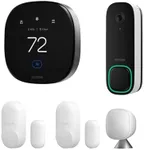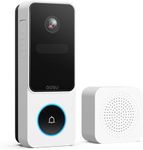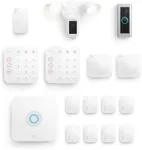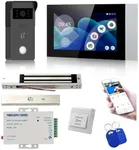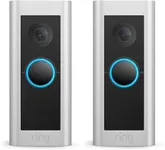Buying Guide for the Best Ring Doorbell Wired
Choosing the right wired ring doorbell can significantly enhance your home security and convenience. When selecting a ring doorbell, it's important to consider various specifications to ensure it meets your needs. Understanding these key specs will help you make an informed decision and find the best fit for your home.Video ResolutionVideo resolution determines the clarity and detail of the footage captured by the doorbell camera. Higher resolution means clearer images and better ability to identify faces and details. Common resolutions include 720p, 1080p, and 2K. For general use, 1080p is usually sufficient, providing a good balance between clarity and data usage. If you need more detailed footage, especially for larger properties, consider a 2K resolution.
Field of ViewThe field of view (FOV) indicates how wide the camera can see. A wider FOV allows the camera to capture more of the area in front of your door. Typical FOV ranges from 90 degrees to 180 degrees. For most homes, a FOV of around 120 degrees is adequate, covering the front porch and immediate surroundings. If you have a larger entryway or want to see more of the surroundings, opt for a wider FOV.
Night VisionNight vision capability allows the doorbell camera to capture clear footage in low-light or dark conditions. This is crucial for 24/7 security. Look for doorbells with infrared (IR) LEDs or other night vision technology. The effectiveness of night vision can vary, so consider models that offer clear images up to a certain distance, typically 15-30 feet. Choose based on how well-lit your entryway is at night and your security needs.
Two-Way AudioTwo-way audio enables you to communicate with visitors through the doorbell. This feature is useful for greeting guests, giving instructions to delivery personnel, or deterring potential intruders. Ensure the doorbell has clear audio quality and minimal delay. If you frequently interact with visitors or need to manage deliveries, this feature is essential.
Motion DetectionMotion detection alerts you when someone approaches your door, enhancing security by notifying you of activity. Advanced models offer customizable motion zones and sensitivity settings to reduce false alerts. If you live in a busy area or have pets, look for doorbells with adjustable settings to avoid constant notifications. Choose based on the level of activity around your home and your need for timely alerts.
Power SourceWired doorbells require a connection to your home's existing doorbell wiring. This ensures continuous power without the need to recharge batteries. Check the voltage requirements and compatibility with your current wiring. If you prefer a hassle-free, always-on solution and have existing wiring, a wired doorbell is ideal. Ensure your home’s wiring can support the doorbell you choose.
Smart Home IntegrationSmart home integration allows the doorbell to connect with other smart devices and systems, such as voice assistants (Alexa, Google Assistant) and smart locks. This enhances convenience and security by enabling features like voice commands and automated routines. If you have a smart home setup or plan to build one, ensure the doorbell is compatible with your preferred ecosystem.
Storage OptionsStorage options determine how video footage is saved and accessed. Common options include cloud storage and local storage (SD cards). Cloud storage often requires a subscription but offers easy access and secure backup. Local storage avoids recurring fees but may have limited capacity. Choose based on your preference for accessibility, security, and whether you are comfortable with subscription fees.
